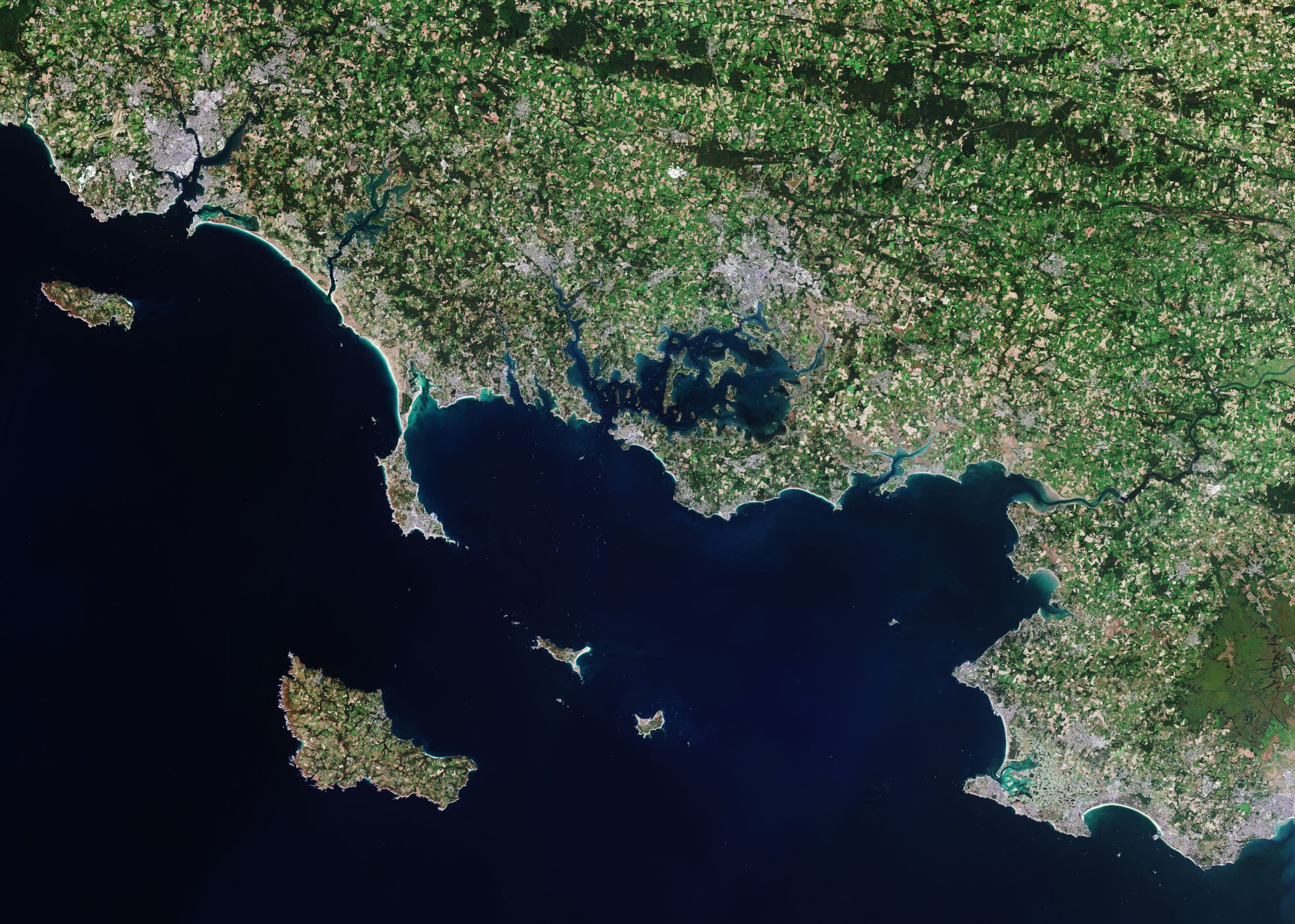La missione Copernicus Sentinel-2 ci porta su Morbihan, un dipartimento francese nel sud della Bretagna.
La Bretagna è una regione di importanza culturale che si trova nel nord-ovest della Francia ed è divisa in quattro dipartimenti: Ille-et-Vilaine ad est, Côtes d'Armor a nord, Finistère ad ovest e Morbihan a sud.
Morbihan deriva il suo nome da ‘Mor-Bihan’ che significa ‘piccolo mare ’ nel linguaggio bretone. Il golfo di Morbihan, visibile al centro dell’immagine, è una delle caratteristiche più famose della linea costiera, con numerose isole ed isolotti. Il golfo è lungo circa 20 km percorso da est ad ovest, mentre misura circa 15 km nel tratto da nord a sud. Si apre sulla baia di Quiberon, attraverso uno stretto passaggio tra Locmariaquer e Port-Navalo.
Nella baia si possono scorgere molte navi ed imbarcazioni. Sono inoltre visibili numerose isole, incluse le piccole isole di Houat e Hœdic e la grande isola di Belle Île, quest’ultima visibile in basso a sinistra nell’immagine. Belle Île è conosciuta per la sua scogliera dal profilo tagliente visibile sul lato sud ovest, ma è anche nota per le sue spiagge ed il suo rinomato festival lirico.
La città portuale di Lorient è visibile in alto a sinistra nell’immagine. La città è posta sulla riva destra del fiume Scorff, alla sua confluenza con il Blavet sul golfo di Biscaglia. L’isola di Groix si trova alcuni chilometri al largo di Lorient. quest’isola presenta scogliere molto alte sulla sua costa settentrionale e spiagge sabbiose in calette appartate lungo la costa meridionale.
Morbihan è anche conosciuta per i suoi ‘allineamenti di Carnac’, che sono costituiti da file di circa 3000 pietre erette e tombe megalitiche. Le pietre si ritiene siano state erette durante il periodo Neolitico, intorno al 4500 a.C. La maggioranza di queste pietre si trova all’interno del villaggio bretone di Carnac, altre invece si trovano ad est all'interno de La Trinité-sur-Mer.
In questa immagine - che è stata acquisita il 13 settembre 2020 - si può vedere come i campi dominino la campagna francese. La Bretagna è conosciuta per la sua ricca e variegata agricoltura ed anche per la produzione di carni e latticini. Fornisce frutta e vegetali di alta qualità, tra cui pomodori, piselli e fagiolini.
Copernicus Sentinel-2 è una missione progettata per fornire immagini che possano essere utilizzate per distinguere i differenti tipi di raccolti, ma anche dati su numerosi indici vegetali, come l'area fogliare, la clorofilla fogliare e l'acqua fogliare: tutti indici essenziali per monitorare accuratamente la crescita delle piante.
Scarica immagine MediumRes (14,55 MB - .JPG)
Scarica immagine HiRes (213,09 MB - .TIF)
---
Morbihan, France
The Copernicus Sentinel-2 mission takes us over Morbihan – a French department in the south of Brittany.
Brittany is an important cultural region in the northwest of France and is divided into four departments: Ille-et-Vilaine in the east, Côtes d'Armor in the north, Finistère in the west and Morbihan in the south.
Morbihan takes its name from ‘Mor-Bihan’ which means ‘little sea’ in the Breton language. The Gulf of Morbihan, visible in the centre of the image, is one of the most famous features of the coastline with numerous islands and islets. The gulf is around 20 km long from east to west and around 15 km wide from north to south. It opens onto the Bay of Quiberon by a narrow passage between Locmariaquer and Port-Navalo.
Many ships and vessels can be seen in the bay. Several islands are visible in the image, including the small islands of Houat and Hœdic and the large Belle Île, which is visible in the bottom-left of the image. Belle Île is known for the sharp cliff edges visible on the southwest side, but also for its beaches and renowned opera festival.
The town and sea port of Lorient is visible in the top-left of the image. The town is situated on the right bank of the Scorff River at its confluence with the Blavet on the Bay of Biscay. The island of Groix lies a few kilometres off Lorient. The island has high cliffs on its north coast and sandy beaches in secluded coves on the south coast.
Morbihan is also known for its ‘Alignements de Carnac’ which consists of rows of around 3000 standing stones and megalithic tombs. The stones were said to be erected during the Neolithic period, around 4500 BC. Most of the stones are within the Breton village of Carnac, but some to the east are within La Trinité-sur-Mer.
Fields dominate the French countryside as seen in this image captured on 13 September 2020. Brittany is known for its rich and varied agriculture including meats and dairy products, but also provides a variety of high quality fruit and vegetables including tomatoes, strawberries, peas and green beans.
The Copernicus Sentinel-2 mission is designed to provide images that can be used to distinguish between different crop types as well as data on numerous plant indices, such as leaf area, leaf chlorophyll and leaf water – all essential to monitor plant growth accurately.
(Fonte: ESA - Image of the week: "Morbihan, France". Traduzione: Gianluca Pititto)
Copia qui lo "short link" a questo articolo
www.geoforall.it/{sh404sef_shurl}




